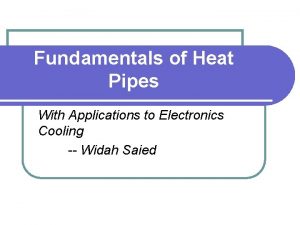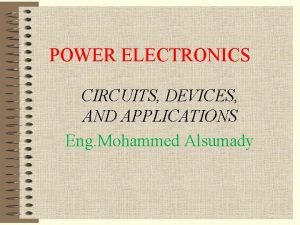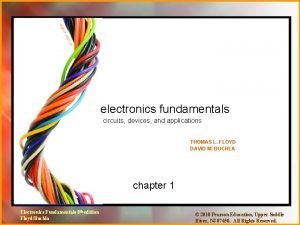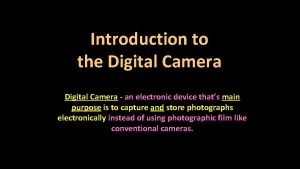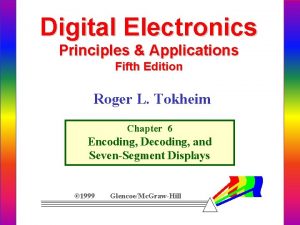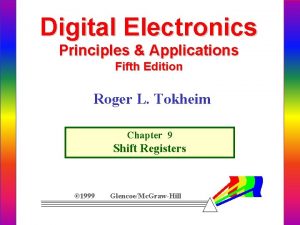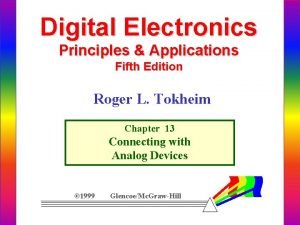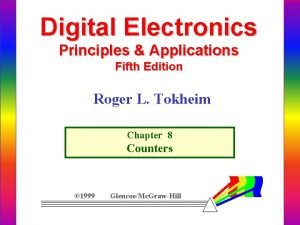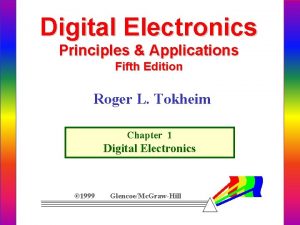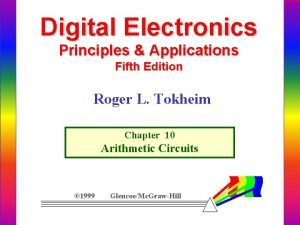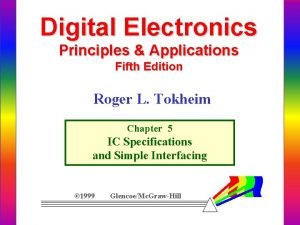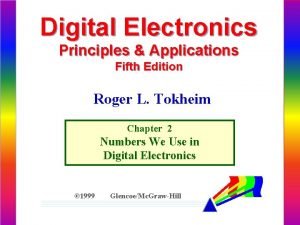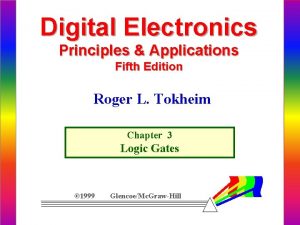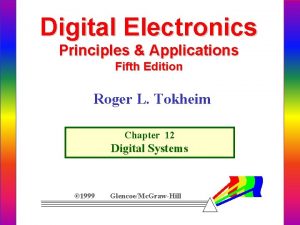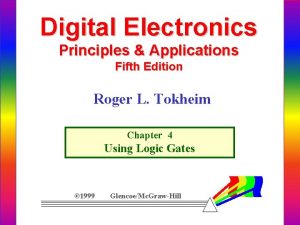Digital Electronics Principles Applications Fifth Edition Roger L












- Slides: 12

Digital Electronics Principles & Applications Fifth Edition Roger L. Tokheim Chapter 11 Memories © 1999 Glencoe/Mc. Graw-Hill

CHAPTER 11 PREVIEW • Overview of Memory • Random Access Memory (RAM) • Read Only Memory (ROM) • Programmable ROM (PROM) • Nonvolatile Read/Write Memory • Memory Packaging • Computer Bulk Storage Devices

OVERVIEW OF MEMORY Three Important Characteristics of Semiconductor Memory: • Density - Amount of data that the memory can store • (Non-) Volatility - Data storage capability if power is disconnected • Read/write capability - Capability to update memory

OVERVIEW OF MEMORY (Cont’d. ) Categories of Semiconductor Storage Cells: • SRAM (static random-access memory) • DRAM (dynamic random-access memory) • ROM (read-only memory) • EPROM (electrically programmable ROM) • EEPROM (electrically erasable PROM) • Flash Memory See next slide for characteristics of each category of memory.

OVERVIEW OF MEMORY (Cont’d. ) Important Semiconductor Memory Characteristics: High Density EPROM DRAM Flash Non Volatile EEPROM SRAM + battery Electrically Updatable Courtesy of Intel Corporation

RANDOM-ACCESS MEMORY (RAM) Characteristics of RAM: • Data can be “written” to RAM • Stored data can be “read” at any time • Volatile - cannot be used for permanent memory • Access to any memory location (address) at any moment Types of RAM: • SRAM (static RAM) - stores data in flip-flop-like cells. Holds 0 or 1 as long as IC has power (volatile). • DRAM (dynamic RAM) - memory cells need refreshing many times per second. Also volatile.

READ-ONLY MEMORY (ROM) Characteristics of ROM: • Non-volatile - memory is not lost when power is turned off • Data is stored permanently • Data stored in ROM can be “read” at any time • ROM cannot be reprogrammed • High density

PROGRAMMABLE READ-ONLY MEMORY (PROM) Data can be programmed or “burned” into a PROM Types of PROM: • Mask-programmable ROM (usually simply called ROM) • Field-programmable ROM (PROM) • Erasable programmable ROM (EPROM) • Electrically erasable PROM (EEPROM or E 2 PROM) • Flash EEPROM

NONVOLATILE READ/WRITE MEMORY • SRAM with battery backup - Typically a long-life lithium battery • NVSRAM (non-volatile static RAM) - Better access speed and overall life than SRAM with battery backup • Flash Memory - Nonvolatile - In-system rewritable (read/write) - Highly reliable - Low power consumption - High density

MEMORY PACKAGING Common Methods of Packaging Semiconductor Memory: • DIP (dual in-line package) • SIP (single in-line package) • ZIP (zig-zag in-line package) • SIMM (single in-line memory module) • Memory cards

COMPUTER BULK STORAGE DEVICES Primary storage - computer’s internal storage Secondary storage - external storage Types of secondary storage devices: • Mechanical Devices - Punched paper card - Punched or perforated paper tape • Magnetic Devices - Magnetic tape (sequential-access device) - Magnetic drum - Hard disk - Floppy disk

COMPUTER STORAGE DEVICES Types of Secondary Storage Devices (cont’d. ): • Optical Devices - CD-ROM (Read-only) - WORM (write-once, read-many) - Read/write • Semiconductor Devices - Flash EEPROM semiconductor
 Principles of marketing fifth european edition
Principles of marketing fifth european edition Psychology ciccarelli 5th edition
Psychology ciccarelli 5th edition Fundamentals of corporate finance fifth edition
Fundamentals of corporate finance fifth edition Fifth edition chemistry a molecular approach
Fifth edition chemistry a molecular approach Segregat
Segregat Molecular biology of the cell fifth edition
Molecular biology of the cell fifth edition Human anatomy fifth edition
Human anatomy fifth edition Human anatomy fifth edition
Human anatomy fifth edition Heat pipes for electronics cooling applications
Heat pipes for electronics cooling applications Power electronics circuits devices and applications
Power electronics circuits devices and applications Electronics fundamentals circuits devices and applications
Electronics fundamentals circuits devices and applications A digital camera is an electronic device
A digital camera is an electronic device Setup time and hold time in digital electronics
Setup time and hold time in digital electronics








